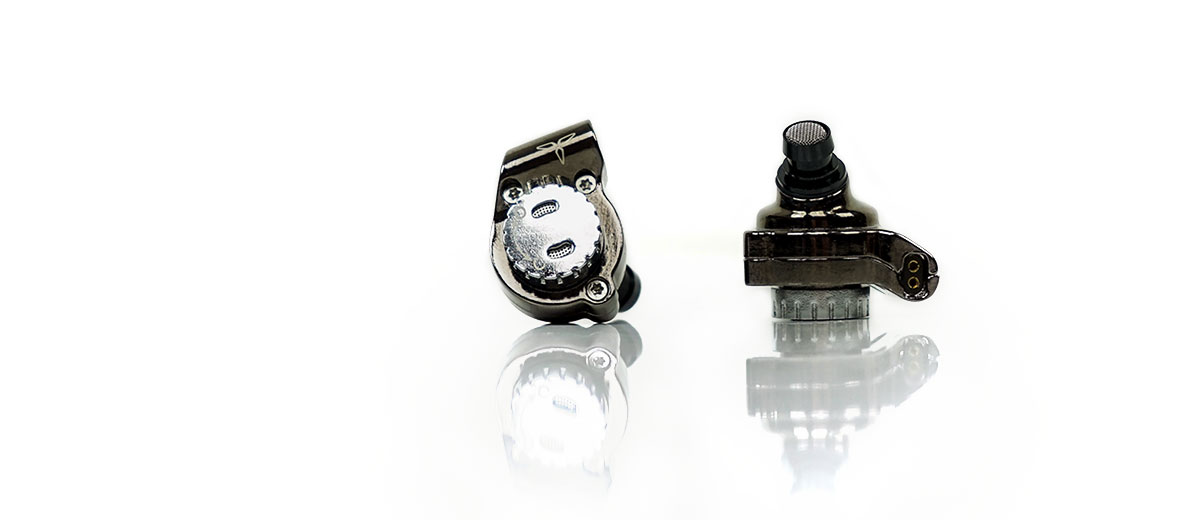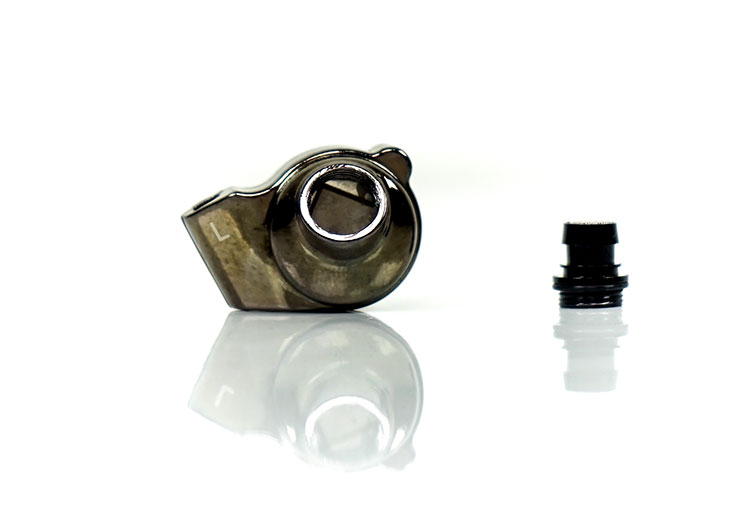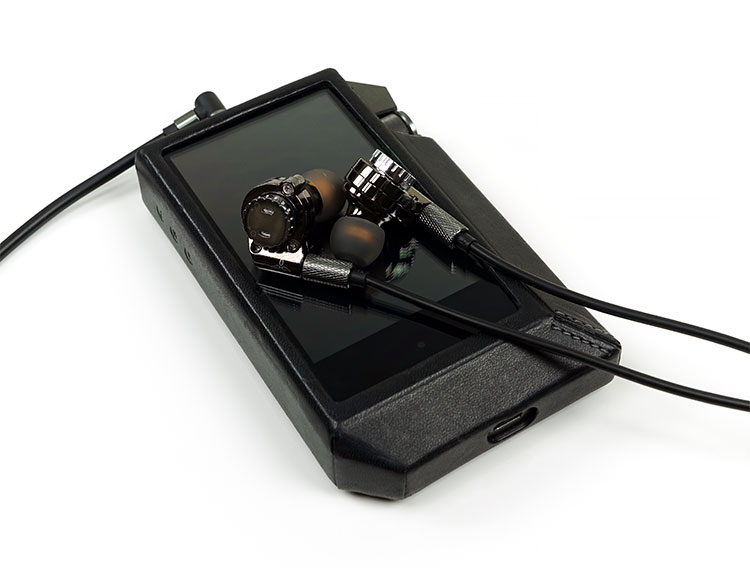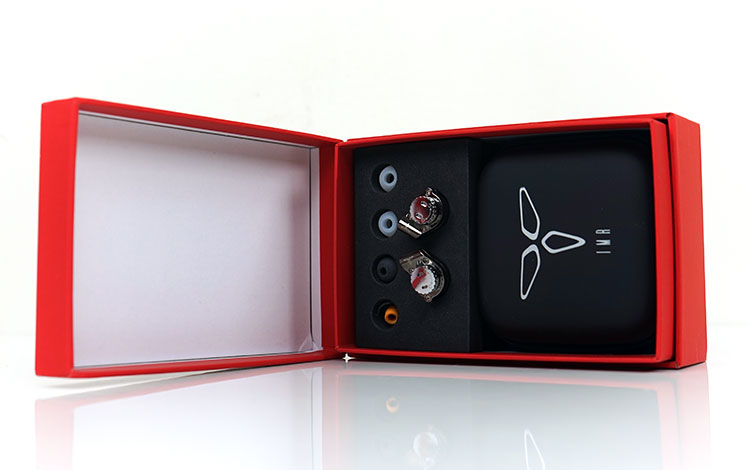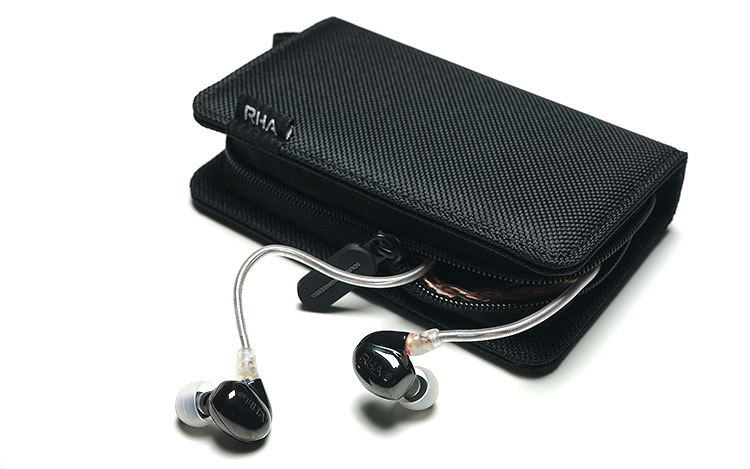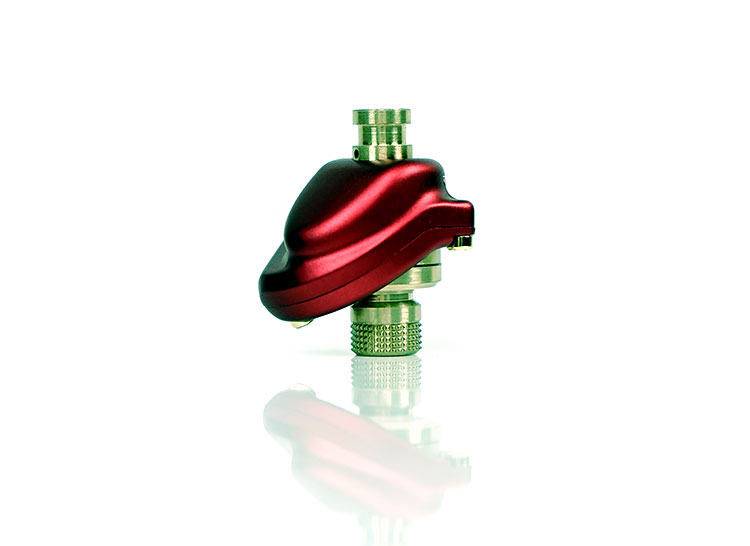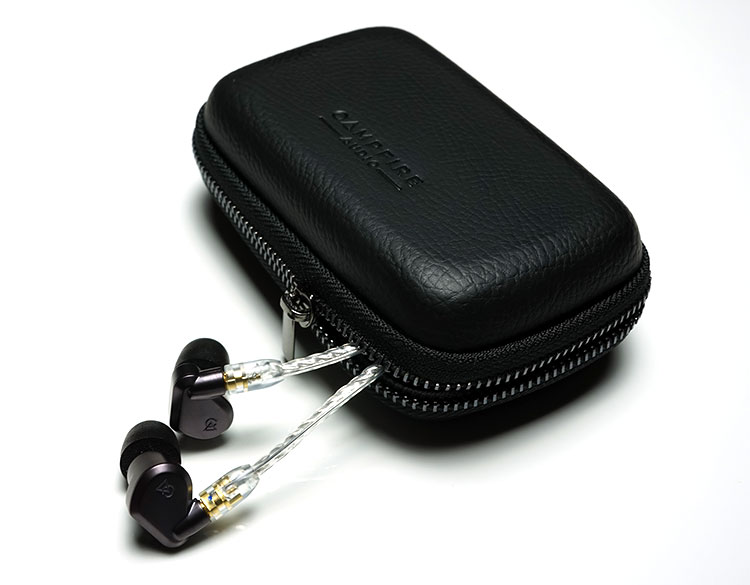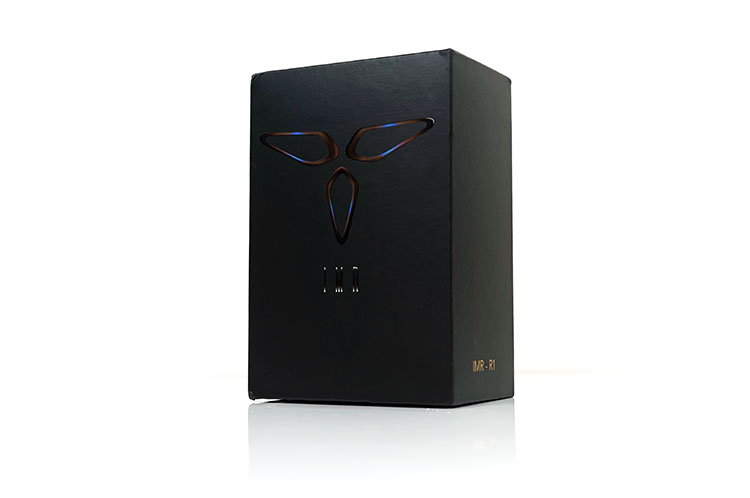Sound Impressions
Tonality & Presentation
Due to the filter system, the R1 does not have one single core presentation or tonal coloring. Each of the filters will produce a very different result so it is much easier to simply to work within that framework.
Black Filter
The black filter is the most colored of filters. Screwed into the R1 you get a deep almost V-shaped and sub-bass dominant response. There is some excellent lower treble contrast keeping the presentation engaging and very musical to the ear.
Bass
Oddly, there is a frequency response graph on the main website for the R1. Of which filter this chart represents I cannot tell you. Comparing it to an FR with the black filter screwed in and the difference in the response curve was huge.
You are talking as much as a +12-18dB difference between the low-end up to 200Hz and a rather more linear curve for the official chart. The remainder of the response curve is largely unaffected beyond 2k for both charts. However, the black filter upper mids curve will seem more pronounced due to the heavier dip from the mid-bass down into the lower mids. I can only assume the relatively mild u-shape and slightly forward upper mids and lower treble of the official chart is without any filter at all.
Mids & Treble
The sub-bass power is hugely emphasized but what I like about this driver is that it never sounds messy. IMR has tuned the response for a slow linear drop from 30Hz before bottoming out at 800hz. This means the power doesn’t bleed all over the place so you avoid an overly warmed up lower-midrange drowning out the vocals. The pronounced dip in the lower-mids also means instrumental timbre is more in the neutral side.
The instrumental positioning on the black filter will seem further back due to the more forward and aggressive low end. Male vocals will fall back into the mix a little though some higher pitched female will benefit from an uplift in energy from 1.5kHz onwards.
The upper treble on the black filter is also a little attenuated with a fairly quick roll-off post 7k before a little bump at 12k. It means the sparkle and air is not huge but it also prevents a harmonic imbalance on percussion attacks meaning the signature is actually smooth and easy on the ear with nothing in the way of peakiness.
Pink Filter
If anything, the Pink filter sounds closer to the official graph posted on their website. Here the bass is far more linear with only a sliver of sub-bass emphasis of approximately 2-3dB but stretches from 200hz right down to 30Hz.
There is still a minor dip in the lower mids for better clarity and instrumental separation. Instrumental timbre here is natural to neutral sounding and have a little more presence, particularly percussion. The upper mids and treble response remains largely unaffected but because of the lack of sub-bass dominance, you do get a much clearer and slightly more n-shaped focus on the R1 with the pink filter.
The energy still sits around 1.5k to 7k so female vocals on the R1 stand out for me and sounds wonderfully smooth. The R1’s lower treble sounds smooth and leaks any peakiness. It does benefit from an upper treble response dip that takes the edge off any potentially undesirable partial overtones but it does lack a bit of air as a result.
Copper Filter
The copper filter is definitely the maximum bass quantity filter and positively dominates the presentation of the R1. This is a true bass head filter. That means you get less of a linear drop from 200Hz into the lower mids compared to the black filter. Staging will also sound deeper and marginally wider with the copper filter than any other filter.
The sustained mid-bass elevation bringing a fair bit of warmth with it into the upper bass and lower-mids pushing forward instrumental positioning and fattening up the body a bit more. As such, instrumental timbre is richer and warmer compared to the other filters but instrumental separation not quite as clean and clear sounding.
Vocals also sound thicker with a richer texture and are slightly more liquid sounding than the pink and black filters. You get a bit more perceptible presence and a very forgiving sound, particularly on female vocals.
The top-end on the copper also sounds more attenuated than the pink and perhaps even the black filter. You still get a reasonable level of lower treble energy so I would not describe it as muted. Instead, you get a laid-back treble response, lacking in air, but with good weight and body up to 7k.
Orange Filter
The orange filter retains some of the warmth from the copper filter but greatly reduced the low-end which is now less aggressive and less weighted than either the black or copper filter. It still retains a fuller-body than the pink with more mid-bass bias and a richer instrumental timbre.
Mids shine a bit more as a result sounding more open and spacious than the copper filter. instrumental separation and clarity are better though note body is still on the weightier side than the neutral pink filter. Generally, I find the mids of the orange filter a more relaxing and easy-going listening experience.
Treble tends to follow the same pattern with a smooth but slightly attenuated final octave which robs it a little of air and placing more focus on the upper mids and lower treble. It remains a smooth easy going and slightly laid-back top-end. The FR from 1.5k onwards on the R1 doesn’t change a huge amount but our perception does as the bass-weight changes with each filter.
Blue Filter
Perfect, well for me it is. This one is also closer to the official FR chart with a balanced sound right across the board. I think most people, except for the most hardcore bassheads will gravitate to the blue filter. Again, the bass is far more linear in response. Still slightly elevated but lacking in any huge dips and bumps and without any obvious bias. It is not lacking or rolled off right down to 30Hz.
There is again a slight dip in the lower mids pulling back instrumental positioning and sitting just in behind the presence region. Instrumental timbre is more on the neutral side this time with excellent separation and clarity. All of this helps the blue filter tease out a bit more in terms of imaging and nuanced detail that helps with spatial cue awareness; something I prefer even on my day and daily listening.
Vocals are further forward but not out of whack and overly focused on compared to the pink filter. Upper mids to lower treble transition still retains that core energy but its smooth, clear and well controlled with slightly more sparkle and perceptible articulation than the pretty much all the other filters.
Matchability
Efficiency
The R1 is rated at 32Ω with a sensitivity level of 108dB. That is actually pretty nimble for a dynamic driver. Given that RHA’s hybrid ceramic driver IEMs, the CL1 and CL750, all chime in at 150Ω and sub-100dB I think IMR have done a great job keeping the R1 relatively easy to drive in comparison.
The R1 is easier to drive than the dynamic driver of the Lyla MK2 from Campfire Audio but only just. The Lyra MK2 is rated at an easy 17.5Ω but has a lower level of sensitivity at 102dB so you do not need huge power but the volume levels are more or less the same as the R1.
However, the R1 is not as easy to drive as the HS1551 CU which is also rated at 32Ω and just a little more sensitive at 110db. It is not a huge gap but noticeable when volume matched on my Opus#2 by around 20 steps on the single-ended output in low gain.
Power
By the way, both are better driven on high-gain on the Opus#2 rather than low gain. Low gain is almost 120-140 on the Opus#2 volume and in the red for the R1. In fact, across most DAPs (and portable amps) I felt the R1 needed a little more juice than your typical BA low ohm high sensitivity IEM.
It will sound ok on a smartphone but if you really want the best dynamic range possible and keep that low-end deep and tight, especially on the black filter, then I would opt for something with decent power and good clarity such as the R6 from HiBy or the iBasso DX200. The R6 will not skew impedance either. That 10Ω output impedance is fairly moot with the R1’s 32Ω rating.
Noise
For noise, the R1 is excellent in that regard. Its performance is almost the same as the HS1551 CU and the Lyra II with the CU perhaps showing a tiny bit more hiss on higher amping noise floors such as the Class A output of the Lear FSM-02 V2 and the ALO Audio V5 but you really have to be looking for it. Otherwise pretty much all DAPs and portable amps tested on the R1 sounded quiet with good black background performances.
Select Comparisons
Tricky in a word because of the filter system. With 5 different sound signatures and no one single core presentation you can almost pull a filter per every debate and shout “aha but what about this one!”. Still, the mid-fi dynamic driver market is looking a lot healthier this year than previous years with more and more trying to grab that somewhat affordable sweet spot.
RHA CL1
$549.95
Technical
The CL1 is notable also for it hybrid ceramic tweeter and dynamic driver but both companies are UK based but that may be as far as it goes. The CL1 uses MMCX, R1 2-pin, both have balanced cable options but the CL1 is wedded to mini-XLR only and their L1 DACamp system. The R1 flips the 2-pin on the side making it tricky for aftermarket as well.
The CL1 dumped the filter system of the T-series so it is more fixed in tonality. It is also rated at 150Ω and 89dB making it almost the polar opposite for driving to the R1. You need a damn good amp with the CL1 whereas the R1 needs more than a smartphone but will run just fine with a good DAP. The odd tuning of the CL1 also means it is far pickier with amps than the filter based R1.
Performance
Ultimately it depends on the filter for the final presentation and tonal bias between the two. On a crude level, the CL1 is perceptibly the more articulate and ethereal but also the fussy one for pairing with a pronounced treble peak that can deliver a lot of sharp overtones and sibilance. It is airier and extends more beyond 7k whereas the R1 on all of the filters is a bit more laid back and not as extended.
The low end of the CL1 has a nice level of impact but the weighting of the sub-bass response is lower unless you switch to the pink or blue filter on the R1 then it does sound warmer and punchier in parts.
The mids on the CL1 do dip a bit to 1k and in some ways the black filter on the R1 mirrors that dip. The copper and orange push up the lower mids infusing a much richer timbre with the better body but they are not quite as precise as the CL1’s cleaner more neutral timbre.
I do love the control and detail on the CL1 with great amps particularly with instrumental positioning and spatial cues. The R1 is not quite as precise and leans more to a musical smooth flavoring that generally should be much easier on the ear particularly with vocals which are very smooth sounding.
Acoustune HS1551 CU
$450
Technical
If the HS1551 CU did not exist I would say the R1 gets my vote as the most unique design of 2018. However, the HS1551 CU ergo it is more unique. This is a proprietary single dynamic driver IEM with a brass chamber acoustic system measuring in at 32Ω and 110dB. It is a touch easier to drive than the R1 out of most sources with similar noise performance.
No filter system here either but the accessory kit is every bit as awesome and the carry case is outstanding. In fact, the HS1551 CU might just get the award in this standoff for going beyond the pale for accessories. In the R1’s favor it does have a balanced 2.5mm cable which the HS 1551 does not but since both are detachable systems then you can, of course, use a cable with the MMCX terminated HS 1551 CU. It is a bit harder with the flipped 2-pin system of the R1. One other thing to note is the level of isolation. The HS 1551 CU level of isolation is lower than the R1.
Performance
If anything, the HS1551 Cu is the IEM that will give the R1 the closest run for its money. Its single tonality is warm, full-blooded with a good low-end power and a top-end that is not overly airy but more relaxed and natural sounding. It peaks in more or less the same places as the R1 up to 7k then drops down beyond with a minor bump at 12k much like the R1.
The HS 1551 CU instrumental timbre is rich, even harmonic biased and liquid in tone. The R1 varies a bit more than that with the filter system but closest to that type of presentation would be the orange filter. In fact, side by side, they sound very close with perhaps just a little more low-end impact from the HS 1551 CU and a slightly wider soundstage. Once you move to the black or copper the R1 changes markedly sounding more aggressive and V-shaped in the case of black or just simply bass head levels in the case of the copper filter.
Campfire Audio Lyra II
$699
Technical
The Lyra is much smaller and lighter than the R1. This is also a single dynamic driver using CA’s custom 8.5mm beryllium PVD transducer and finished in a very nice PVD coating also. I give props to CA for the finish, just a little smoother than the R1. The R1 is a touch bigger but both are comfortable, easy to fit in the ear with the Lyra Mk2 having the slightly superior seal.
The Lyra MK2 is a touch harder to drive at 102dB sensitivity rating compared to the 100dB of the R1. It does need a nice source and amp signal but not a huge amount. It does not scale quite like its bigger sibling the Vega but tightens up more with good DAPs. The R1 will sing louder and better on weaker sources but again, a good DAP or portable amp will scale it a bit better for dynamic range.
Performance
The R1 has the stronger low-end with more sub-bass presence than the Lyra MK2. Only when you go to the Pink filter do you get any sense the Lyra MK2 is hitting any harder from the mid-bass downwards.
That being said the Lyra resolves just that little bit better, especially on the mids which are a little further forward sounding. The R1 comes a good deal closer to the resolution of the Lyra MK2 using the blue balanced filter. However, on the copper and black the mids take second place to the aggression of the low-end and lack the same clinical precision of the Lyra. Instrumental timbre on the Lyra MK2 is between the blue and orange filter of the R1 with a rich and warm hue sound to instruments and generally good body.
Staging on the Lyra is a bit narrower and more intimate than the R1 which casts a deeper and wider soundstage. The Lyra has a little more treble energy and will sound the more extended and perceptibly cleaner of the two though not an overly airy signature in its own right. Still, side by side the R1 using black and orange will sound the darker. The blue is the one that comes closest to closing that little treble energy gap with its cleaner and more balanced signature.
Our Verdict
True to form Bob and the team from IMR Acoustics have created an audiophile chameleon and a very good one at that with the R1. I always said it is a clever route to go with filters because it takes the risk out of nailing that one great tonal signature that you think most will like and turns it into the musical form of ‘spread betting’ at the bookies. Instead of saying you love or hate it you start thinking well this filter is better than that filter. The power of choice is a clever tool if used properly and in the case of the R1 I think it works.
At its heart, the R1 is musical with sold low-end fundamentals and a relaxed top-end. It is a fun sounding IEM that can be controlled very nicely with the filters to go in any direction you want, be it basshead, more linear or just something you can use on an everyday basis on any genre you choose. The level of resolution is on par with its nearest competitors also so it is not all impact and no substance.
The only thing about the R1 that did not move me that much was the dial itself. Having used semi-open IEMs and fully open ones the difference between open and closed was a little too nuanced to go wow. I would encourage Bob to tinker with this and see what more can be done with the system to make the difference more dramatic.
Apart from that, I think the R1 is great value and well worth a demo if you are after a solid musical IEM, or perhaps even 5 solid musical IEMs?
IMR Acoustics R1 Specifications
- 13mm driver featuring Neodymium motors with beryllium diaphragm + Ceramic driver
- IMR Open and close porting system
- 5 Audio filters
- 2 Pin detachable cable
- Impedance: 32 Ohm
- Sensitivity: 108 +/- 3DB
- Frequency response: 14 – 40000Hz
- 24ct Gold plated 3.5mm Jack
- 1.4M length OFC cable
- Hard Case
- 6.5mm Adapter

